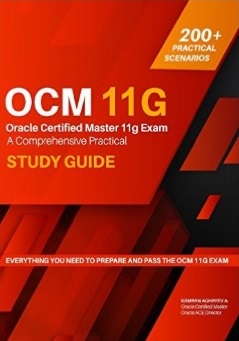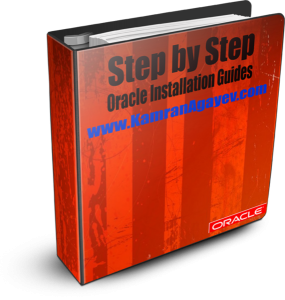RMAN Video Tutorial Series – Convert database from Windows to Linux using RMAN
Posted by Kamran Agayev A. on August 20th, 2010
In this video tutorial I show the convertion of the database from Windows to Linux using CONVERT DATABASE command in RMAN. Enjoy it
To download the .mp4 version of this file, use the following link
http://www.kamranagayev.com/Video_Tutorials/RMAN_Convert_Database.mp4









August 20th, 2010 at 1:36 pm
Salam bəy. Mənə həmişə maraqlı olub bu sualı indi ona görə verəcəm
Orda daxile tdiyiniz məlumatları əzbərləmisiniz? yoxsa zamanla məşğul olduqca bədahətən gəlir?
August 20th, 2010 at 1:37 pm
Thank you Kamran, Good presentation.
Wissem
August 20th, 2010 at 3:30 pm
Very Nice video Tutorial
August 20th, 2010 at 7:33 pm
Note1 : 10.2.0.1 has a bug -Bug #5016125- and you cannot run convert in parallel (which can save a lot of time when doing it on large number of datafiles), it is fixed within 10.2.0.4.
Note2 : you can also do the database convert without converting all the datafiles but just the datafiles containing rollback segments (undo), it also saves a lot of time (see Avoid Datafile Conversion during Transportable Database [ID 732053.1]).
Nicolas.
August 21st, 2010 at 1:00 am
Eline sağlık Kamran, baya zamanını alıyordur eminim.
August 21st, 2010 at 9:23 am
Respect !!!
August 21st, 2010 at 3:30 pm
Great Job ^^
August 24th, 2010 at 2:03 am
Salam Kamran.
Tutorillara gore sene yeqin yeni bashlayanlar chox teshekkur edirler. Her halda sen de yaxshi bilirsen ki, professionallar bu videoya ancaq tekrarlamaq uchun baxirlar. Onlar bilirler ki, baza gerek archivelog mode rejiminde ishlesin. Lakin yeni bashlayanlar adi halda oracleni install edende noarchivelog mode rejiminde ishleyir. Mence sen tutoriallarda bunu nece elemeyi de gostersen pis olmazdi. Hech olmasa videodan kenarda bunlari qeyd ele.
SQL> select log_mode from v$database;
LOG_MODE
————
NOARCHIVELOG
SQL> shutdown immediate
Database closed.
Database dismounted.
ORACLE instance shut down.
SQL> startup mount
ORACLE instance started.
Total System Global Area 188743680 bytes
Fixed Size 1218436 bytes
Variable Size 96471164 bytes
Database Buffers 88080384 bytes
Redo Buffers 2973696 bytes
Database mounted.
SQL> alter database archivelog;
Database altered.
SQL> alter database open;
Database altered.
SQL> select log_mode from v$database;
LOG_MODE
————
ARCHIVELOG
Evvelki “Performing Disaster Recovery with RMAN” tutorialinda flash_recovery_area katalogunu da yaratmaq yadindan chixmishdi. Fikrimce yeni bashlayanlar uchun bunlar chox vacibdir. Bunlari ona gore yaziram ki, dostuma senin blogunu meslehet gordum ve o, tutoriallari tekrarlayanda bu suallari mene verdi.
P.S. Chox sagol ki, bele tutoriallar hazirlayirsan. Maraqli tutoriallarini sebirsizlikle gozleyirem.
Hormetle Samir Imanov
August 24th, 2010 at 10:12 am
Salam Samir, feedback ucun tesekkur edirem
Menim bu video tutoriallarda esas meqsedim, xususen RMAN ile elaqeli backup ve recovery addimlarini Oracle DBA-lerine gostermekdir. Bashlanqic olaraq bunlar Oracle-a yeni bashlayanlar ucun nezerde tutulub, ancaq zaman kecdikce daha complex recovery addimlarini gostermek fikrim de var
Yeni bashlayanlar eslinde noarchivelog-da database-in backup-in ala bilmediyini gordukde, google-dan database-i nece archivelog-a cevirmek lazim olduqunu cox asanliqla tapa bilerler, ancaq video-dan kenarda bunu qeyd ederem
Flash Recovery Area-ya geldikde ise, bu default olaraq 10g-de database quranda avtomatik secilmis bir secenekdi, yeni istifadeci Next duymelerini basmaqla database qurmaq istese, avtomatik Flash Recovery Area onun ucun configure olacaq
Bir daha feedback-a gore tesekkurler
August 24th, 2010 at 1:33 pm
Elbette database quranda avtomatik kataloq oui terefinden yaradilir. Hemchinin adump, bdump… kataloqlari da ele o zaman yaranir. Amma software only sechilen zamani bunlar yaranmir. Mence 2-ci virtual mashinda evvelceden baza yuklenmish ve sonradan silinmishdir. Diqqetle baxdiqda hetta $ORACLE_HOME kataloqunda evvelki admin/ kataloqu da gorunur, hansi ki, soft only rejiminde yaranmir. Elbette bunlar xirdaliqlardir, amma tutorialin chox komeyi var.
P.S. Google-de axtarmaq barede duz deyirsen. Menim de fikrimce eger kimse oracle-ni oyrenmek isteyirse melumatin serbest halda tapilmasini da oyrenmelidir.
September 16th, 2010 at 6:27 am
Teşekkürler Kamran güzel paylaşım ellerine sağlık
November 21st, 2010 at 9:58 pm
Teshekkurler……
November 25th, 2010 at 12:10 pm
Thank you Kamran Sir for this wonderful presentation.
I follow each and every steps which you demonstrate in this video.
But when i execute TRANSPORT.SQL script at linux, after sometime i am getting ORA-03114 error : not connected to ORACLE.I donot understand why this happening.
Can you please help me out to over come this problem?
November 25th, 2010 at 12:15 pm
Dear Prageet
Create the fresh database “without OLAP” and you’ll success (It’s a bug)
If you want to clone the database with already OLAP installed database, then just remove it (There’s a metalink note on deleting OLAP)
November 29th, 2010 at 10:39 am
Dear Kamran sir,
Thank you for your support.I have created a new database without OLAP.Its help me to come out from that problem.And now i am able to clone the database. Once again thanks for your help.
November 29th, 2010 at 10:40 am
Wouuu, that’s great! Congratulations!
January 31st, 2011 at 11:42 pm
Is it possible to Convert Windows 2008 R2 64 bit Oracle Database to RHEL 6 32 bit?
Also, windows 2008 is live database i dont want to loose anything.
February 3rd, 2011 at 12:08 am
Hi Kamran,
This is third day i still can not convert. i’ve been googling and also have some paid suport contract.
My Databse does not open in READ ONLY MODE.
1. as soon as i issue the command SHUTDOWN IMMEDIATE. it works fine
Database closed.
Database dismounted.
ORACLE instance shut down.
2. now when i try to open it using STARTUP MOUNT, i get the following error.
ORA-24324: service handle not initialized
ORA-01041: internal error. hostdef extension doesn’t exist
Please please please help.
February 3rd, 2011 at 2:02 pm
Dear Ashwin
Could you please post output (the error you get) from alert.log file
February 4th, 2011 at 8:06 pm
Great Job and useful too
February 8th, 2011 at 9:48 am
Hello Kamran,
please discard my precious post…It worked great!!!! I’m converting from Windows 2008 64-bit to Linux 32 bit platform….i’m still working on it and @TRANSPORT.SQL stage, i’ll post here if i have any problem,please help if i get stuck.
thank you so much for all your help.
Ashwin
February 8th, 2011 at 10:45 pm
Hello Kamran,
This is what i’m getting from last two days.
ORA-32006: BACKGROUND_DUMP_DEST initialization parameter has been deprecated
ORA-32006: USER_DUMP_DEST initialization parameter has been deprecated
ORA-01261: Parameter db_recovery_file_dest destination string cannot be translated
ORA-01262: Stat failed on a file destination directory
Linux Error: 2: No such file or directory
CREATE CONTROLFILE REUSE SET DATABASE “A2TEST” RESETLOGS NOARCHIVELOG
*
ERROR at line 1:
ORA-01034: ORACLE not available
Process ID: 0
Session ID: 0 Serial number: 0
ALTER DATABASE OPEN RESETLOGS
*
ERROR at line 1:
ORA-01034: ORACLE not available
Process ID: 0
Session ID: 0 Serial number: 0
ALTER TABLESPACE TEMP ADD TEMPFILE ‘/home/app/oracle/product/11.2.0/dbhome_1/oradata/a2test/temp01.dbf’
*
ERROR at line 1:
ORA-01034: ORACLE not available
Process ID: 0
Session ID: 0 Serial number: 0
~~~~~~~~~~~~~~~~~~~~~~~~~~~~~~~~~~~~~~~~~~~~~~~~~~~~~~~~~~~~~~~~~~~
* Your database has been created successfully!
* There are many things to think about for the new database. Here
* is a checklist to help you stay on track:
* 1. You may want to redefine the location of the directory objects.
* 2. You may want to change the internal database identifier (DBID)
* or the global database name for this database. Use the
* NEWDBID Utility (nid).
~~~~~~~~~~~~~~~~~~~~~~~~~~~~~~~~~~~~~~~~~~~~~~~~~~~~~~~~~~~~~~~~~~~
ORA-01034: ORACLE not available
ORA-27101: shared memory realm does not exist
Linux Error: 2: No such file or directory
ORA-32006: BACKGROUND_DUMP_DEST initialization parameter has been deprecated
ORA-32006: USER_DUMP_DEST initialization parameter has been deprecated
ORA-01261: Parameter db_recovery_file_dest destination string cannot be translated
ORA-01262: Stat failed on a file destination directory
Linux Error: 2: No such file or directory
SQL>
SQL> WHENEVER SQLERROR EXIT;
SQL>
SQL> DOC
DOC>#######################################################################
DOC>#######################################################################
DOC> The following statement will cause an “ORA-01722: invalid number”
DOC> error if there the database was not opened in UPGRADE mode
DOC>
DOC> If you encounter this error, execute “SHUTDOWN”, “STARTUP UPGRADE” and
DOC> re-execute utlirp.sql
DOC>#######################################################################
DOC>#######################################################################
DOC>#
SQL> SELECT TO_NUMBER(‘MUST_BE_OPEN_UPGRADE’) FROM v$instance
2 WHERE status != ‘OPEN MIGRATE’;
SELECT TO_NUMBER(‘MUST_BE_OPEN_UPGRADE’) FROM v$instance
*
ERROR at line 1:
ORA-01034: ORACLE not available
Process ID: 0
Session ID: 0 Serial number: 0
Disconnected
-bash-4.1$
February 10th, 2011 at 10:31 am
Dear Ashwin
According the error you get (ORA-32006: BACKGROUND_DUMP_DEST) I hope you’re using 11g. Don’t you?
Please post some entry from your alert.log file
February 11th, 2011 at 2:22 am
Hi Kamran,
Here is the situation,
1. I’ve ORACLE 10g running on windows 2008 R2 (64-bit) with ERP system.
2. I want to move to RHEL6.
now, i’ve built RHEL6 server (32-bit) to test. First i tried with Oracle 10g on RHEL6 didnt work, now i’m trying Oracle 11g on RHEL6.
I’m good with Linux but not with Oracle, i’m following each step from your video tutorial. Again today, i re-install fresh copy of 11g on RHEL6, let me try and i’ll post the result.
February 11th, 2011 at 8:46 pm
Hello Kamran,
Please help…..
I’m soooooo glad today atleast Control file created……please help Kamran…here is the result.
SQL> @TRANSPORT.SQL
ORA-32006: BACKGROUND_DUMP_DEST initialization parameter has been deprecated
ORA-32006: USER_DUMP_DEST initialization parameter has been deprecated
ORA-01081: cannot start already-running ORACLE – shut it down first
Control file created.
ALTER DATABASE OPEN RESETLOGS
*
ERROR at line 1:
ORA-01092: ORACLE instance terminated. Disconnection forced
ORA-00704: bootstrap process failure
ORA-39700: database must be opened with UPGRADE option
Process ID: 2608
Session ID: 19 Serial number: 3
ERROR:
ORA-03114: not connected to ORACLE
~~~~~~~~~~~~~~~~~~~~~~~~~~~~~~~~~~~~~~~~~~~~~~~~~~~~~~~~~~~~~~~~~~~
* Your database has been created successfully!
* There are many things to think about for the new database. Here
* is a checklist to help you stay on track:
* 1. You may want to redefine the location of the directory objects.
* 2. You may want to change the internal database identifier (DBID)
* or the global database name for this database. Use the
* NEWDBID Utility (nid).
~~~~~~~~~~~~~~~~~~~~~~~~~~~~~~~~~~~~~~~~~~~~~~~~~~~~~~~~~~~~~~~~~~~
ORA-24324: service handle not initialized
ORA-01041: internal error. hostdef extension doesn’t exist
ORA-24324: service handle not initialized
ORA-01041: internal error. hostdef extension doesn’t exist
SQL>
SQL> WHENEVER SQLERROR EXIT;
SQL>
SQL> DOC
DOC>#######################################################################
DOC>#######################################################################
DOC> The following statement will cause an “ORA-01722: invalid number”
DOC> error if there the database was not opened in UPGRADE mode
DOC>
DOC> If you encounter this error, execute “SHUTDOWN”, “STARTUP UPGRADE” and
DOC> re-execute utlirp.sql
DOC>#######################################################################
DOC>#######################################################################
DOC>#
SQL> SELECT TO_NUMBER(‘MUST_BE_OPEN_UPGRADE’) FROM v$instance
2 WHERE status != ‘OPEN MIGRATE’;
ERROR:
ORA-03114: not connected to ORACLE
Disconnected from Oracle Database 11g Release 11.2.0.1.0 – Production
February 19th, 2011 at 2:09 am
Dear Kamran,
Please help!!!!!!!!!!!!. I tried all different ways to convert but I’m stuck at here and can not go further.
ERROR at line 1:
ORA-01194: file 1 needs more recovery to be consistent
ORA-01110: data file 1: ‘/home/oracle/app/oracle/oradata/a2test/SYSTEM01.DBF’
SQL> CREATE CONTROLFILE REUSE SET DATABASE “A2TEST” RESETLOGS ARCHIVELOG
2 MAXLOGFILES 16
3 MAXLOGMEMBERS 3
4 MAXINSTANCES 8
5 MAXLOGHISTORY 4672
6 LOGFILE
7 GROUP 1 ‘/home/oracle/app/oracle/oradata/a2test/redo01.log’ SIZE 50M,
8 GROUP 2 ‘/home/oracle/app/oracle/oradata/a2test/redo02.log’ SIZE 50M,
9 GROUP 3 ‘/home/oracle/app/oracle/oradata/a2test/redo03.log’ SIZE 50M
10 DATAFILE
11 ‘/home/oracle/app/oracle/oradata/a2test/SYSTEM01.DBF’,
12 ‘/home/oracle/app/oracle/oradata/a2test/UNDOTBS01.DBF’,
13 ‘/home/oracle/app/oracle/oradata/a2test/SYSAUX01.DBF’,
14 ‘/home/oracle/app/oracle/oradata/a2test/USERS01.DBF’
15 CHARACTER SET WE8MSWIN1252;
Control file created.
SQL> ALTER DATABASE OPEN RESETLOGS;
ALTER DATABASE OPEN RESETLOGS
*
ERROR at line 1:
ORA-01194: file 1 needs more recovery to be consistent
ORA-01110: data file 1: ‘/home/oracle/app/oracle/oradata/a2test/SYSTEM01.DBF’
SQL>
February 20th, 2011 at 10:23 pm
Dear Ashwin
Recover the database before opening it in RESETLOGS mode usind RECOVER DATABASE command
February 23rd, 2011 at 3:17 pm
Güzel bir video olmuş Kamran. Tebrikler.
February 23rd, 2011 at 3:22 pm
Merhaba Ugur. Bloguma hos geldin
Feedback icin tesekkurler
March 8th, 2011 at 1:11 am
hi Kamran,
I’ve tried everything, still stuck at the same place “ORA-01194: file 1 needs more recovery to be consistent”
I’ve tried,
1. recover database using backup control file
2. recover database using backup control file until cancel
Still getting the error ” Recovery successfull but you will get the following error”
ERROR at line 1:
ORA-01113: file 1 needs media recovery
ORA-01110: data file 1: ‘/home/oracle/app/oracle/oradata/a2test/SYSTEM01.DBF’
April 14th, 2011 at 6:40 pm
hi kamran,
I have been trying to convert oracle 10g database on Enterprise linux to windows from past three days and i am getting a error like
RMAN> convert database new database ‘lindadb’
2> transport script ‘/u01/transport.sql’
3> db_file_name_convert ‘/u01/app/oracle/oradata/raj’ ‘/u01/test’
4> to platform ‘Microsoft Windows IA (32-bit)’;
Starting convert at 14-APR-11
using target database control file instead of recovery catalog
allocated channel: ORA_DISK_1
channel ORA_DISK_1: sid=153 devtype=DISK
External table SH.SALES_TRANSACTIONS_EXT found in the database
Directory SYS.ADMIN_DIR found in the database
Directory SYS.WORK_DIR found in the database
Directory SYS.DATA_FILE_DIR found in the database
Directory SYS.LOG_FILE_DIR found in the database
Directory SYS.MEDIA_DIR found in the database
Directory SYS.XMLDIR found in the database
Directory SYS.SUBDIR found in the database
Directory SYS.DATA_PUMP_DIR found in the database
BFILE PM.PRINT_MEDIA found in the database
User SYS with SYSDBA and SYSOPER privilege found in password file
channel ORA_DISK_1: starting datafile conversion
input datafile fno=00001 name=/u01/app/oracle/oradata/raj/system01.dbf
RMAN-00571: ===========================================================
RMAN-00569: =============== ERROR MESSAGE STACK FOLLOWS ===============
RMAN-00571: ===========================================================
RMAN-03009: failure of backup command on ORA_DISK_1 channel at 04/14/2011 18:52:27
ORA-19504: failed to create file “/u01/test/system01.dbf”
ORA-27040: file create error, unable to create file
Linux Error: 2: No such file or directory
PLZ help me
thanks in advance.
April 14th, 2011 at 6:43 pm
Dear Rajesh
Check whether the /u01/test directory exists and the “oracle” user has necessary privileges on it
April 14th, 2011 at 8:44 pm
dear sir
thank u sir..
May 10th, 2011 at 4:31 pm
can i have video tutorial for 10g to 11g migration
May 10th, 2011 at 11:10 pm
Dear Raj
It’s not so hard to upgrade the database from 10g to 11g. You have two options: DBUA (Database Upgrade Assistant) and manual migration.
You can refer to the upgrade documentation
http://download.oracle.com/docs/cd/E11882_01/server.112/e17222/upgrade.htm#i1011372
July 5th, 2011 at 2:21 pm
Please send me Different scenerios of RMAN recovery on Linux environment
July 5th, 2011 at 2:35 pm
Check my video tutorials from the following link:
http://kamranagayev.wordpress.com/oracle-video-tutorials/
November 3rd, 2011 at 3:59 pm
Dear Kamran,
I have the same problem as Ashwin Patel. I try to migrate my database from windows server 2008 r2 (Oracle version 11.1.0.6.0) to Solaris x86 (Oracle version 11.2.0.2.0).
But when i try to execute the transport.sql script, i get the error:
SQL> @/u01/app/oracle/oradata/omega/TRANSPORT.SQL
ORACLE instance started.
Total System Global Area 2405122048 bytes
Fixed Size 2226472 bytes
Variable Size 1509951192 bytes
Database Buffers 872415232 bytes
Redo Buffers 20529152 bytes
Control file created.
ALTER DATABASE OPEN RESETLOGS
*
ERROR at line 1:
ORA-01194: file 1 needs more recovery to be consistent
ORA-01110: data file 1: ‘/u01/app/oracle/oradata/omega/SYSTEM01.DBF’
ALTER TABLESPACE TEMP ADD TEMPFILE ‘/u01/app/oracle/oradata/omega/TEMP01.DBF’
*
ERROR at line 1:
ORA-01109: database not open
~~~~~~~~~~~~~~~~~~~~~~~~~~~~~~~~~~~~~~~~~~~~~~~~~~~~~~~~~~~~~~~~~~~
* Your database has been created successfully!
* There are many things to think about for the new database. Here
* is a checklist to help you stay on track:
* 1. You may want to redefine the location of the directory objects.
* 2. You may want to change the internal database identifier (DBID)
* or the global database name for this database. Use the
* NEWDBID Utility (nid).
~~~~~~~~~~~~~~~~~~~~~~~~~~~~~~~~~~~~~~~~~~~~~~~~~~~~~~~~~~~~~~~~~~~
ORA-01109: database not open
Database dismounted.
ORACLE instance shut down.
ORACLE instance started.
Total System Global Area 2405122048 bytes
Fixed Size 2226472 bytes
Variable Size 1509951192 bytes
Database Buffers 872415232 bytes
Redo Buffers 20529152 bytes
Database mounted.
ORA-01589: must use RESETLOGS or NORESETLOGS option for database open
SQL>
SQL> WHENEVER SQLERROR EXIT;
SQL>
SQL> DOC
DOC>#######################################################################
DOC>#######################################################################
DOC> The following statement will cause an “ORA-01722: invalid number”
DOC> error if there the database was not opened in UPGRADE mode
DOC>
DOC> If you encounter this error, execute “SHUTDOWN”, “STARTUP UPGRADE” and
DOC> re-execute utlirp.sql
DOC>#######################################################################
DOC>#######################################################################
DOC>#
SQL> SELECT TO_NUMBER(‘MUST_BE_OPEN_UPGRADE’) FROM v$instance
2 WHERE status != ‘OPEN MIGRATE’;
SELECT TO_NUMBER(‘MUST_BE_OPEN_UPGRADE’) FROM v$instance
*
ERROR at line 1:
ORA-01722: invalid number
Disconnected from Oracle Database 11g Enterprise Edition Release 11.2.0.2.0 – 64bit Production
With the Partitioning, OLAP, Data Mining and Real Application Testing options
Please, help me to solve this problem.
November 26th, 2011 at 8:20 am
Hi, Kamran,
Is it possible convert database from OS that ENDIAN_FORMAT field is different from another one?
for example:
from: Windows 2003 x32 Oracle 11gR1
to: Solaris 10.u5 x64 (sparc) Oracle 11gR2
November 30th, 2011 at 10:36 am
No it’s not possible, for this you need to use CONVERT TABLESPACE command
August 30th, 2012 at 11:08 am
hello kamran
please check
https://forums.oracle.com/forums/thread.jspa?threadID=2428541&tstart=45&start=30
thanks in advance
oraenthu@live.com
October 22nd, 2012 at 3:46 pm
Dear Kamran,
Thanks for the video ..
October 22nd, 2012 at 4:04 pm
Dear Kamran,
We have currently Oracle 10gR2 on windows and we need to migrate the database to RHEL with Oracle 11gR2..
1)Is it possible to migrate from Oracle 10gR2 on windows to RHEL with Oracle 11gR2
or
2)Is it possible to migrate from Oracle 10gR2 on windows to RHEL with Oracle 10gR2 first then upgrade oracle with 11gR2
Please suggest me sir
current version
===============
SQL> select platform_id, platform_name from v$database;
PLATFORM_ID PLATFORM_NAME
———– —————————————-
7 Microsoft Windows IA (32-bit)
October 30th, 2012 at 11:21 am
Hi Venkat
I would suggest you to move it to 10g Linux and then upgrade it to 11g